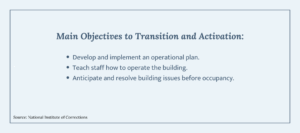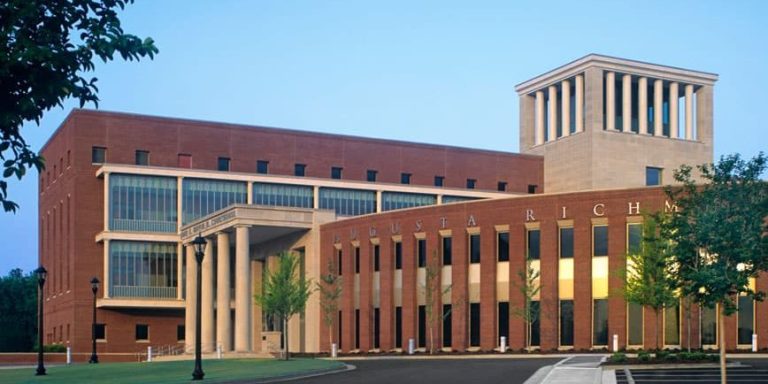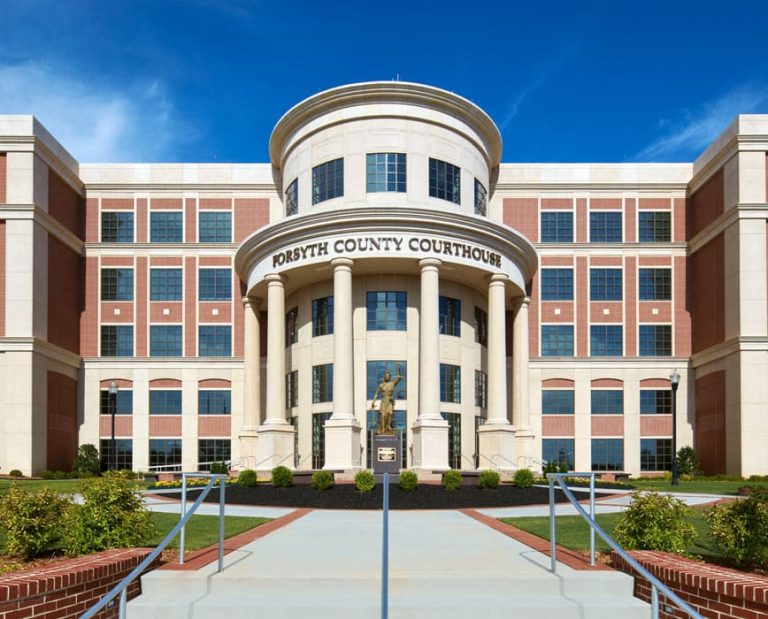
Navigating Transition and Activation Pt 1: The Four Main Stages of T&A
As a facility owner or administrator faced with the development of a new criminal justice facility, ensuring a smooth Transition and Activation process is paramount to the success of your project. Transition and Activation services play a crucial role in seamlessly bringing the facility online, optimizing operations, and maximizing efficiency from day one.
However, in my more than 30 years in the field of criminal justice I’ve come to realize that not everybody really understands what transition services entail and how complex the service line really is.
Over the course of my career, I’ve overseen and performed Transition and Activation services for multiple projects, including state correctional facilities and local adult and juvenile detention facilities. Today, I’ll give a high-level overview of what Transition and Activation is at its core; the steps involved in Transition and Activation planning; and what’s required of the Transition Team during this process.
Getting Down the Basics
WHAT is Transition and Activation and WHY is it important?
Transition and activation services are necessary when planning or building a new building or expansion. The purpose of Transition and Activation services is to give facility Owners and their staff a guide of how to plan for and move into a new building successfully and efficiently. Ultimately, the design and the construction of a facility provides the physical plant aspect of security for that new site. Transition planning is preparing operations to meet the intended design of the physical plant.
According to the National Institute of Corrections (NIC), there are three main objectives to Transition and Activation:
- Develop and implement an operational plan.
- Teach staff how to operate the building.
- Anticipate and resolve building issues before occupancy.
Why is this service so important and needed? The reality is most owners have never built or moved into a new facility. This is all foreign to them. They lack an understanding of the complexity transition planning involves and almost all of them lack sufficient staff to have a dedicated Transition Team.

WHO is involved in Transition and Activation?
You’ll need a good team by your side to get this done right. And they’ll need ample time to dedicate to the effort.
The Transition Team should ideally consist of internal staff members and stakeholders who possess hands-on, day-to-day knowledge of the agency’s operations and have intimate knowledge of the needs of both staff and incarcerated persons (IPs) within the facility. It’s important the team has the proper time to focus solely on Transition and Activation efforts. Often, this may require several full-time, 40-hour/week assignments, which can be challenging for Owners with limited or overworked staff.
Recognizing this, Owners may opt to appoint an internal transition coordinator and key internal subject matter experts or bring in a third-party consultant to steer the process and keep it on track. The transition coordinator plays a pivotal role in guiding the Transition Team through the various stages of Transition and Activation. Their job is to ensure the end results reflect the communicated needs of the building occupants while maintaining alignment with the project’s overarching goals and objectives.
Being on or leading a Transition Team is a lot of work, and a lot of time invested, but it’s worth it. By involving these individuals early in the planning process, their insights can significantly influence decision-making, ensure alignment with operational requirements, and safeguard against costly mistakes and change orders.
The Four Main Stages of Transition and Activation
Now that we’ve got a grasp of the “Who,” “What,” and “Why,” of Transition and Activation, let’s talk about the “When” and the “How.” Below, I outline the four main stages of the Transition and Activation process, highlighting key responsibilities and providing insights into how to navigate each stage effectively.

Stage One: Operational Planning
The first stage of Transition and Activation services is Operational Planning. Operational Planning is getting the building occupants familiar with the design of the new building. It’s getting them to understand the operational workflows, how the architects involved in the planning designed workflows to occur within that facility. During this phase, the focus is on developing a comprehensive plan that outlines the strategies and processes required to transition the facility from construction to full operational capacity.
The Transition Team plays a pivotal role in this stage, collaborating closely with stakeholders to identify key objectives, establish timelines, and allocate resources effectively. This stage is where the Transition Team identifies operational changes required in the new facility and begins crafting and recrafting procedures to meet the operational changes. The Transition Team should start by collecting all their existing policies. If your agency is anything like most county government agencies, you probably have copies of policies dating back several decades or more. That’s ok – this is an opportunity to get rid of old, obsolete policies; to initiate some new policies and update (or eliminate) forms; to transition to electronic processes, etc… It’s important to look at all publications that inform the public and the inmate population, the services available, and how the building functions – all that needs to be updated and touched upon the opening of a new building.
Once the team has determined new operating practices and identified those that require change, the Transition Team will begin developing a training curriculum used to educate all staff and inmates of how the facility will operate. Training and communicating the changes is vital to building excitement and increasing morale to accept inevitable change.
Lastly, every operational planning stage needs to consider the impact the new design will have on security staff. Transition teams work to develop staffing analyses for the new facility and compare them to available staff resources. If there is a deficit, Transition Teams begin working with agency human resource divisions to coordinate recruitment efforts to ensure appropriate staffing levels are available upon the facility opening.
Responsibilities of the Transition Team during Operational Planning include:
- Conducting a thorough assessment of operational requirements and facility readiness.
- Working with construction companies to coordinate building systems and signage messaging; ensuring internal communication and security systems are clear and understandable.
- Developing detailed operational plans for each department or functional area within the facility.
- Developing training protocols for staff and occupants at all levels.
- Analyzing staffing needs to ensure budgetary needs are identified and prepared in advance.
- Identifying potential risks and developing mitigation strategies to ensure a smooth transition.
- Establishing communication protocols and channels to keep all stakeholders informed throughout the process.
Types of questions to address during Operational Planning:
- What are the specific operational requirements of the new facility? (ex: How are the keys going to be labeled and controlled? What’s the process for chemical control? Tool control? Etc…)
- What are the critical milestones and timelines for the transition process?
- How will communication be managed between stakeholders during the transition period?
- What are the potential risks and challenges associated with the transition, and how can they be mitigated?

Stage Two: Procurement and Preparing for Fit-Up
In Stage Two, the focus shifts to procurement and preparing the facility for fit-up. This stage involves procuring necessary equipment, furnishings, and supplies, as well as ensuring that the facility’s infrastructure is fully operational and ready to support operational needs.
With a new building comes a procurement package for basic furnishings and standard equipment that goes along with the Furniture, Fixtures, and Equipment (FF&E) package. Generally, office accessories and specific security equipment are not included in the FF&E package. Items such as whiteboards, clocks, undercounter refrigerators, medical equipment, metal detectors, fingerprint machines, etc. are not included in the FF&E package. These items are referred to as “fit-up” and are often the responsibility of the owner to purchase or relocate from existing facilities. There’s coordination work that must occur for every bit of fit-up material that’s not included with the FF&E package. Somebody must think these things through and ensure the equipment is compatible with the new facility (power and data connections, space coordination, adequate ventilation and utility support). Somebody must coordinate the need with the procurement process and guide the Owner through what’s needed and what fits in the space.
The Transition Team and Move Manager (more on that in Stage Four), whether internal or external, work closely with vendors and contractors to coordinate procurement efforts and oversee the fit-up process.
Responsibilities of the Transition Team during Procurement and Preparing for Fit-up include:
- Developing procurement plans and identifying vendors for equipment, furnishings, and supplies.
- Coordinating with contractors to ensure that construction and fit-up activities align with operational timelines.
- Conducting site inspections to verify that infrastructure and systems are installed and functioning correctly.
- Managing inventory and logistics to ensure timely delivery of equipment and supplies.
- Ensuring vendor installations do not void building warranties and do not damage the building.
Types of questions to address during Procurement and Preparing for Fit-up:
- What equipment, furnishings, and supplies are required for the facility’s operation?
- What additional service contracts will be required in the new facility?
- What additional equipment maintenance contracts will be required in the new facility?
- How will procurement activities be coordinated to ensure timely delivery and installation?
- What are the requirements for infrastructure and systems integration, and how will they be addressed?
- How will inventory and logistics be managed to support the fit-up process?

Stage Three: Activation
Stage Three marks the activation of the facility, where operational processes and procedures are implemented, and staff are trained to perform their roles effectively. The Transition Team plays a hands-on role during this stage, overseeing the execution of transition plans and providing support to ensure a successful activation.
This is where the rubber really starts to meet the road and the building is prepped for occupancy. Once the building is in a state where equipment can be installed, the Transition Team goes in and starts turning on equipment, turning on food service, cooling down coolers, getting food relocated, starting to test the equipment, such as security equipment. They’re going to test the locks, make sure doors open and close properly, toilets flush, sinks run; and they’re going to make sure before an IP ever enters a cell that everything in that building works; that they can get an IP in and they can get an IP out in an emergency.
Another aspect of properly preparing the building is making sure that housing units are fully set up. Ensuring that units have mattresses, and that games and things get set up so when the first IP gets in there, everything’s already provided, and staff aren’t rushing after move-in to try to put supplies in housing units. Ensuring property rooms and laundry areas are equipped with bedrolls, uniforms, and footwear.
Responsibilities of the Transition Team during Activation include:
- Implementing operational processes and procedures in accordance with the transition plan.
- Providing training and support to staff to ensure they are proficient in their roles and responsibilities.
- Monitoring the activation process and addressing any issues or challenges that arise.
- Conducting performance evaluations to assess the effectiveness of operational systems and procedures.
Types of questions to address during Activation:
- How will operational processes and procedures be implemented and communicated to staff?
- What training programs are needed to ensure staff are prepared for their roles?
- How will the Transition Team support staff during the activation process?
- How will performance be monitored and evaluated to identify areas for improvement?

Stage Four: Move Management
While traditionally considered the final stage, Move Management should ideally occur concurrently with the first three stages to ensure a seamless transition. Move Management involves coordinating the relocation of staff, equipment, and supplies from existing facilities to the new facility. The Transition Team plays a critical role in overseeing the move and minimizing disruption to operations.
As I previously mentioned, Owners should designate (if internal) or hire (if external) a Move Manager who will head up this process and coordinate everybody’s efforts to move into the building. I’m not only referring to getting the IPs into the building, but also the actual staff. It’s making sure that during the planning phase, everybody’s got an assigned workstation – everybody knows they’re going from this seat in their existing facility to that seat in the new facility. It’s making sure phones are coordinated…making sure fax lines are coordinated… making sure computer terminals work and making sure that everybody has a seat, ultimately.
Managing the move process includes developing an occupancy schedule so that the building has staff and resources in place to accept the relocation of IPs when the time comes. At the same time, staff and resources need to be available at the departing facility to ensure a continuity of supervision and care during the move.
Responsibilities of the Transition Team during Move Management include:
- Developing detailed move plans and schedules to coordinate the relocation process.
- Coordinating with staff and departments to ensure they are prepared for the move.
- Managing logistics and transportation to ensure timely delivery of equipment and supplies to the new facility.
- Conducting post-move evaluations to assess the effectiveness of the relocation process and identify areas for improvement.
Types of questions to address during Move Management:
- What are the timelines and logistics involved in relocating staff and equipment to the new facility?
- How will communication be managed to keep staff informed and prepared for the move?
- What equipment will be moved and when does it get relocated in order to not disrupt current operations?
- What packing supplies are required for employees, agency equipment, and IP belongings?
- In what order will the IP population occupy the new facility and what will the admission process involve?
- What contingency plans are in place to address unexpected challenges or delays during the relocation process?
- How will the Transition Team evaluate the success of the move and identify opportunities for improvement?
Transition and Activation services are essential for ensuring the successful launch of a new criminal justice facility. By understanding and effectively navigating the four main stages – Operational Planning, Procurement and Preparing for Fit-up, Activation, and Move Management – facility owners and administrators can minimize risks and maximize operational efficiency.
This is part one of a two-part series on Transition and Activation. Stay tuned for part two, where we’ll dive deeper into common challenges, lessons learned, and best practices for Transition and Activation teams.




